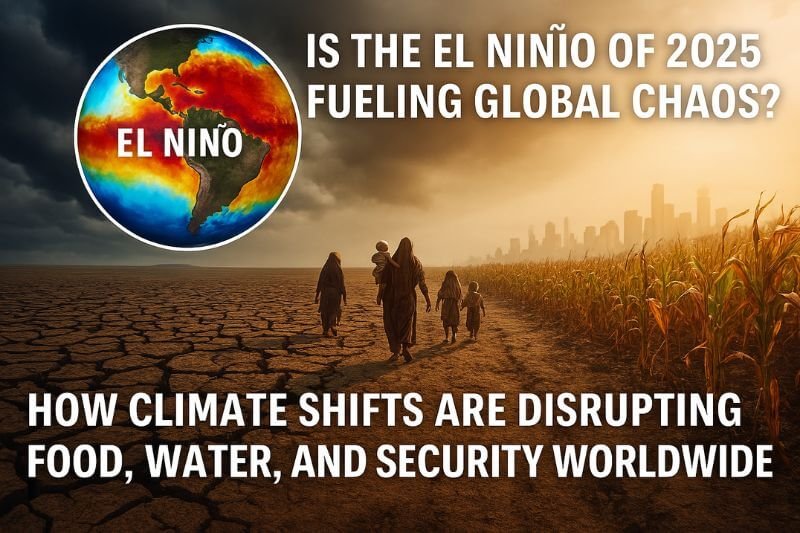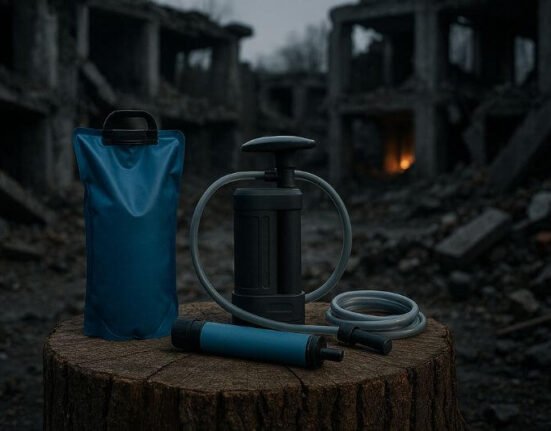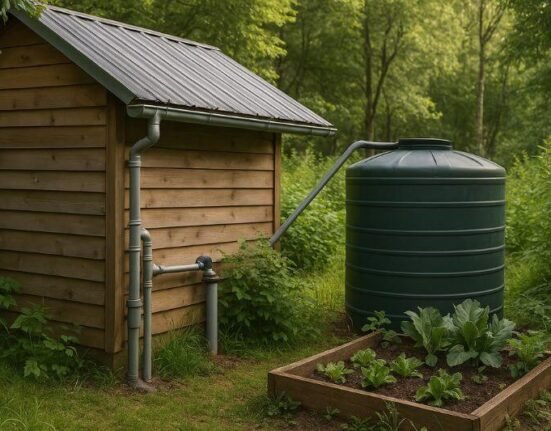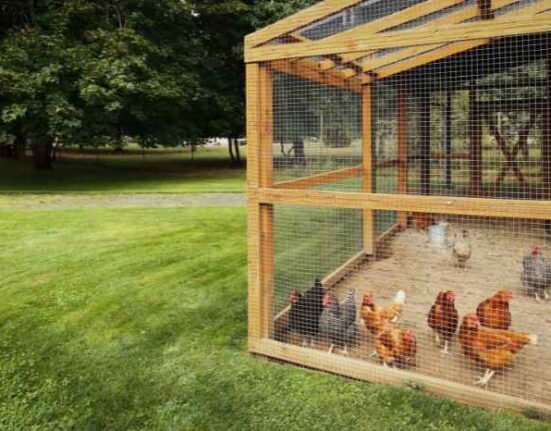How Climate Shifts Are Disrupting Food, Water, and Security Worldwide
When Weather Becomes a Weapon of Instability
The year 2025 has already become one of the most turbulent on record. From crop failures in Africa to flash floods in South America and prolonged heatwaves across Asia, the world is watching as El Niño 2025 unleashes a cascade of climate extremes. But beyond the rising temperatures and shifting rainfall patterns lies a deeper threat: the global systems we depend on—food, water, energy, and political stability—are starting to fracture under the weight of this natural phenomenon.
For survivalists, preppers, and concerned citizens, understanding the implications of El Niño is no longer optional. This is not just a weather pattern; it’s a global stress test that reveals how fragile modern civilization really is. In this article, we explore what El Niño 2025 means for global survival, how it’s disrupting critical resources, and most importantly, what you can do now to prepare for the months and years ahead.
What Is El Niño and Why Is 2025 So Different?
El Niño is a recurring climate pattern caused by the warming of surface waters in the central and eastern Pacific Ocean. It disrupts weather systems across the globe, altering rainfall, wind, and temperature patterns.
While El Niño events occur every 2 to 7 years, the 2025 version is particularly aggressive. Scientists from NOAA and the World Meteorological Organization have declared it one of the strongest in recorded history. Ocean surface temperatures are hovering 2.6°C above average in key regions—levels not seen since the infamous El Niño of 1997–1998, which killed over 20,000 people and caused $45 billion in damages globally.
What Makes El Niño 2025 Exceptional?
- Extended duration – Expected to last up to 18 months, through early 2026
- Double-peak event – Forecast models show a resurgence in intensity later this year
- Amplified global feedback loops – Already interacting with deforestation, polar vortex instability, and ocean current slowdowns
It’s no longer just about temperature. The consequences are rippling through food systems, hydrology, geopolitics, and energy supply chains.
Food Supply at Breaking Point
One of the most immediate consequences of El Niño 2025 is the collapse of agricultural reliability in both developing and developed nations.
Crop Failures Spreading Globally
- Sub-Saharan Africa is seeing maize, millet, and sorghum harvests drop by up to 40% due to prolonged drought and heatwaves.
- India’s wheat belt is suffering extreme heat stress during critical pollination weeks, threatening exports and internal food security.
- California’s Central Valley, responsible for a third of the U.S.’s vegetables, is facing both drought and flash floods—a deadly one-two punch that has wiped out entire harvests.
These disruptions come at a time when global food reserves are already low due to lingering COVID-era supply chain weaknesses and the Ukraine conflict’s continued effect on grain exports.
The Food Shortage Impact in Real Terms
- Global grain prices have risen by 33% since January 2025
- Food riots have erupted in Sri Lanka, Honduras, and Ethiopia
- WFP warns that more than 820 million people may face acute hunger by the end of the year
El Niño 2025 is not just a meteorological event—it’s a global hunger multiplier.
The Global Water Crisis: A Second Front
With shifting rain patterns, freshwater resources are becoming increasingly unreliable.
Drought Zones Are Expanding
- The Amazon basin is now classified as “exceptionally dry,” causing forest fires to rage uncontrollably and further accelerating global warming
- Northern Mexico and parts of the U.S. Southwest have entered their fifth consecutive year of megadrought
- In Australia, farmers are being forced to cull livestock due to water shortages
Meanwhile, flash floods in other regions—like Brazil and Southeast Asia—are contaminating drinking water supplies and destroying water infrastructure.
Cities on the Brink
- Cape Town (South Africa) is once again facing “Day Zero,” with municipal water expected to run dry by August 2025
- Chennai (India) is relying on trucked-in water as reservoirs dry up
- In the U.S., Phoenix and Las Vegas are now under federal water emergency declarations
For survivalists, this marks a major shift. Water is no longer a guaranteed urban utility—it’s now a daily logistical threat.
Security and Stability Are Breaking Down
History shows that climate disasters and political unrest go hand in hand. El Niño 2025 is no exception.
Displacement and Migration
- Over 3.2 million people have been displaced in East Africa alone due to flood-damaged villages and failing crops
- Thousands of climate refugees are arriving at Europe’s southern borders, overwhelming aid systems
- Internal migration is rising in countries like Bangladesh, Peru, and Sudan, creating new economic pressures
Political Flashpoints
- In South Asia, water-sharing agreements are being violated, raising tensions between India and Pakistan
- In Latin America, protests over rising food prices are turning violent
- Cyberattacks on water grid systems in the U.S. have raised suspicions of foreign sabotage, with authorities on high alert
As resources become scarce, conflict over food and water is accelerating. El Niño is not just pushing the climate—it’s pushing governments.
Energy Systems Under Pressure
Hydropower Fails, Fossil Fuels Return
- Brazil and Colombia, heavily reliant on hydroelectric power, are experiencing rolling blackouts due to record-low river levels
- China is rationing energy in key provinces due to fluctuating rainfall and electricity shortages
- In Europe, solar and wind productivity are impacted by abnormal cloud cover and wind stagnation
This has created a dangerous feedback loop: governments are turning back to coal and gas, increasing emissions and exacerbating climate instability.
Survivalist Strategies for El Niño 2025
You can’t stop climate shifts, but you can prepare. Here’s how:
1. Secure Water Independence
- Install rainwater catchment systems with first-flush filters
- Stock long-term water storage (minimum 90 days per person)
- Keep purification tools (gravity filters, chlorine tabs, UV light pens)
2. Build Food Security
- Diversify stored food with climate-resilient staples: lentils, rice, canned proteins
- Create or expand a climate-adapted garden: raised beds, heat-resistant crops, vertical hydroponics
- Learn to preserve food: dehydration, canning, fermentation
3. Prepare for Blackouts and Fuel Disruptions
- Use solar battery banks for essentials (lighting, radios, device charging)
- Store backup fuel and know local fuel barter systems
- Keep a Faraday cage for critical electronics (especially radios and solar controllers)
4. Monitor Migration Patterns
- Map likely internal migration routes from urban to rural zones
- Build trusted local networks to share resources and intelligence
- Avoid areas prone to resource-based conflict
5. Stay Informed and Adapt Fast
- Subscribe to decentralized, independent climate alert systems
- Practice mobility: be ready to relocate temporarily if your zone becomes unlivable
- Keep documents and essentials in waterproof, mobile-ready packs
Psychological Preparedness: Surviving the Slow Collapse
It’s easy to focus on gear and logistics. But mental preparation is just as important.
El Niño 2025 is a slow-moving catastrophe—it won’t be one big explosion, but a series of grinding stresses on your nerves, your habits, and your expectations.
Be prepared for:
- The erosion of normality: what once worked will stop working
- The failure of institutions: governments may respond late—or not at all
- The need to make hard decisions for your family and community
Resilience isn’t just a bunker or a bug-out bag—it’s the capacity to keep functioning when the rules no longer apply.
El Niño 2025 Is the Climate Alarm We Can’t Ignore
Unlike past El Niño events, 2025 is not a seasonal disruption—it’s a systemic wake-up call. From global food insecurity to water rationing, political instability to energy grid strain, this climate cycle is stretching civilization to its limits.
For the informed and prepared, this is a moment to act—not panic. Whether you live in a flood-prone city or a drought-stricken countryside, the time to rethink survival is now.
Don’t wait for the heatwave, the blackout, or the food riot. El Niño 2025 is already here. And the systems we depend on may not be able to carry us through it.
Prepare for disruption. Train for independence. Thrive in chaos.















